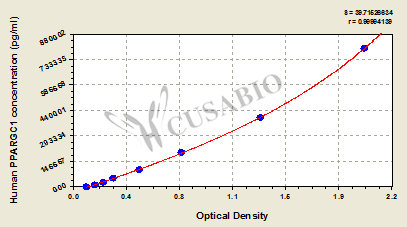Peroxisome proliferator-activated receptor gamma coactivator 1 alpha (PPARGC1A) is a transcriptional coactivator that regulates cellular energy metabolism and mitochondrial biogenesis. This protein coordinates metabolic pathways, particularly in tissues with high energy demands such as skeletal muscle, heart, and liver. PPARGC1A works by coactivating nuclear receptors and transcription factors involved in gluconeogenesis, fatty acid oxidation, and oxidative phosphorylation. The protein is necessary for maintaining metabolic homeostasis and cellular energy production.
This quantitative sandwich ELISA kit measures human PPARGC1A levels in serum, plasma, cell culture supernatants, and cell lysates. The assay provides a detection range of 125 pg/mL to 8000 pg/mL with a sensitivity of 31.25 pg/mL. The kit requires 50-100 μL sample volume and can be completed within 1-5 hours, with detection performed at 450 nm wavelength.
Application Examples
Note: The following application examples are drawn from a selection of publications citing this product. For additional applications, please refer to the full list of references in the "Citations" section.
This ELISA kit has been used in research examining oxidative stress and mitochondrial function markers in human plasma samples. The kit allows quantitative measurement of peroxisome proliferator-activated receptor gamma coactivator 1 alpha as part of biomarker panels in clinical research settings.
• Mitochondrial function studies: Analysis of mitochondrial-related proteins alongside oxidative stress markers in plasma samples to evaluate cellular energy metabolism
• Cardiometabolic research: Examination of metabolic biomarkers in studies analyzing metabolic syndrome components and energy homeostasis regulation
• Clinical intervention studies: Measurement of plasma biomarkers in controlled research protocols involving resistance training and other therapeutic interventions
• Biomarker profiling: Quantification as part of multi-analyte panels analyzing inflammation, kynurenine metabolism, and metabolic health parameters




